Climate change and Low-carbon economy
气候变化英语作文
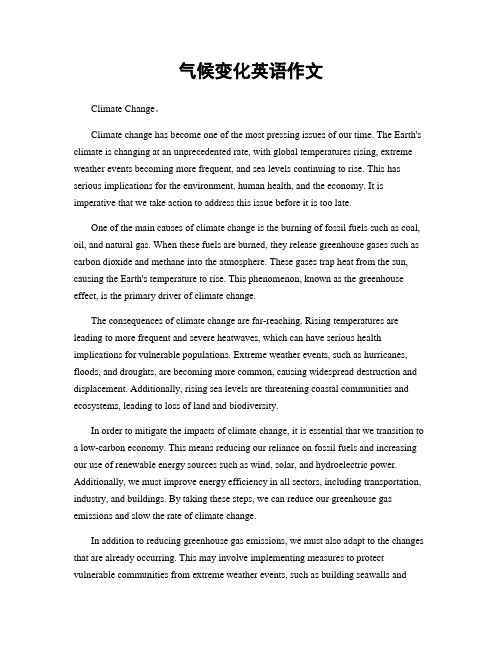
气候变化英语作文Climate Change。
Climate change has become one of the most pressing issues of our time. The Earth's climate is changing at an unprecedented rate, with global temperatures rising, extreme weather events becoming more frequent, and sea levels continuing to rise. This has serious implications for the environment, human health, and the economy. It is imperative that we take action to address this issue before it is too late.One of the main causes of climate change is the burning of fossil fuels such as coal, oil, and natural gas. When these fuels are burned, they release greenhouse gases such as carbon dioxide and methane into the atmosphere. These gases trap heat from the sun, causing the Earth's temperature to rise. This phenomenon, known as the greenhouse effect, is the primary driver of climate change.The consequences of climate change are far-reaching. Rising temperatures are leading to more frequent and severe heatwaves, which can have serious health implications for vulnerable populations. Extreme weather events, such as hurricanes, floods, and droughts, are becoming more common, causing widespread destruction and displacement. Additionally, rising sea levels are threatening coastal communities and ecosystems, leading to loss of land and biodiversity.In order to mitigate the impacts of climate change, it is essential that we transition to a low-carbon economy. This means reducing our reliance on fossil fuels and increasing our use of renewable energy sources such as wind, solar, and hydroelectric power. Additionally, we must improve energy efficiency in all sectors, including transportation, industry, and buildings. By taking these steps, we can reduce our greenhouse gas emissions and slow the rate of climate change.In addition to reducing greenhouse gas emissions, we must also adapt to the changes that are already occurring. This may involve implementing measures to protect vulnerable communities from extreme weather events, such as building seawalls andimproving flood defenses. It may also involve conserving and restoring natural ecosystems, such as wetlands and forests, which can help to mitigate the impacts of climate change.Individuals can also play a role in addressing climate change. By making small changes to their daily habits, such as using public transportation, reducing energy consumption, and recycling, people can help to reduce their carbon footprint. Additionally, they can support policies and initiatives that promote sustainability and environmental protection.In conclusion, climate change is a critical issue that requires urgent action. By reducing greenhouse gas emissions, transitioning to renewable energy sources, and adapting to the changes that are already occurring, we can mitigate the impacts of climate change and create a more sustainable future for generations to come. It is up to all of us to take responsibility for our actions and work together to address this global challenge.。
M5U2_Project__Climate_change_and_a_low

M5U2 Project Climate change and a low-carbon life(第一课时)知识树一、学习目标1. 读懂文章大意,理清文章结构。
2. 能在文中找到相关信息,回答问题。
二、自主学习1. 在课文中找出下列单词或短语,写出它们的中文。
1. climate (L1)2. blame (L2)3. carbon dioxide (L2)4.breathe (L3)5. let off (L4)6. atmosphere (L5)7. vehicles (L5) 8. engines (L5)9. electrical power plants (L1) 10. fuel (L1)11. consume (L8) 12. in this case (L12)13. public transport (L12) 14. underground (L13)15. turn off (L16) 16. in particular (L18)17. last but not least (L22) 18. two decades from now (L24) 19. satisfaction (L25) 20. did your part to (L25)2. 大声朗读课文两遍。
三、合作探究1. 快速浏览课文,回答下列问题。
①. What is this passage mainly about? (No more than 6 words.)It is about .②. What is the main idea of each paragraph?Para. 1. The world climate in recent years and its reason. Para. 2. What we can do to help this problem when we need to travel. Para. 3.How to save at home.Para. 4. We can③. Which of the following diagram(示意图)shows the right structure(结构) of this passage?A. B. C. D.①①①②①②③②③②③④③④④④2. 根据课文内容,判断下列说法是正确的还是错误的。
中国关于碳排放发言稿英文

中国关于碳排放发言稿英文Ladies and gentlemen,Good morning/afternoon/evening. It is a great pleasure to be here today to discuss the issue of carbon emissions in China and its impact on climate change. As one of the world's largest economies and greenhouse gas emitters, China has a crucial role to play in addressing this global challenge, not only for the benefit of its own people but also for the well-being of the entire planet.Firstly, let us examine the current situation of carbon emissions in China. It is undeniable that over the past few decades, China has experienced rapid economic growth and industrialization, which have had a significant impact on its carbon emissions. According to data from the Global Carbon Atlas, China is currently the largest emitter of carbon dioxide (CO2) in the world, accounting for approximately 28% of global emissions in 2019.The consequences of such high levels of carbon emissions are devastating. Climate change is a reality that affects all countries and it has profound implications for the environment, economy, and human health. Rising temperatures, extreme weather events, and the melting of polar ice caps are just some of the impacts that we are already witnessing. If we do not take urgent action to reduce carbon emissions, the consequences will only worsen, leading to irrevocable damage to our planet and the well-being of future generations.However, it is important to note that China is not solely responsible for the current state of global carbon emissions.Historically, developed countries have contributed the most to the accumulation of greenhouse gases in the atmosphere. As we move forward in addressing this issue, it is crucial to adopt a fair and equitable approach that takes into account historical responsibility and national circumstances. It is unfair to ask developing countries like China to make the same level of emission reductions as developed countries, without providing adequate support, resources, and technology transfer.That being said, China acknowledges the urgency and necessity of reducing carbon emissions and has made significant efforts in this regard. The Chinese government has set ambitious climate targets and implemented a range of policies and measures to achieve them. For instance, in 2020, President Xi Jinping announced that China aims to achieve carbon neutrality by 2060. This commitment demonstrates China's determination to address the issue of climate change and transition to a low-carbon economy.To achieve these targets, China is adopting a multi-faceted approach. Firstly, China is investing heavily in renewable energy sources, such as wind, solar, and hydroelectric power. China is already the largest producer of solar panels and wind turbines in the world and has made substantial progress in increasing the share of renewable energy in its energy mix. Furthermore, China is phasing out coal-fired power plants and promoting the use of natural gas as a cleaner alternative.Secondly, China is implementing energy efficiency measures across industries, buildings, and transportation. Through the implementation of energy-saving technologies and practices, Chinaaims to reduce energy consumption and, consequently, carbon emissions. The government is also promoting the development and use of electric vehicles, which have the potential to significantly reduce emissions in the transportation sector.Thirdly, China is exploring carbon capture and storage (CCS) technologies to effectively reduce emissions from industries and power plants. CCS involves capturing CO2 emissions from the source and storing them underground, preventing them from being released into the atmosphere. This technology has the potential to play a significant role in reducing carbon emissions, and China is investing in research and development to make it more cost-effective and commercially viable.In addition to these domestic measures, China is actively participating in international cooperation on climate change. China has ratified the Paris Agreement and is committed to its implementation. China is also contributing to global climate finance and technology transfer, especially to developing countries, to support their efforts in mitigating and adapting to climate change.Ladies and gentlemen, as we navigate the path towards a sustainable future, it is crucial for all countries, including China, to work together in a spirit of cooperation and shared responsibility. Climate change is a global challenge that requires a global response, and no country can solve it alone. Developed countries must fulfill their commitments to provide financial resources, technology transfer, and capacity building support to developing countries. Developing countries, including China, must continuetheir efforts to reduce emissions and transition to low-carbon development pathways.In conclusion, China recognizes the importance of addressing carbon emissions and mitigating climate change. The Chinese government has set ambitious targets and is implementing a range of policies and measures to achieve them. China is investing in renewable energy, promoting energy efficiency, exploring carbon capture and storage technologies, and actively participating in international cooperation. However, achieving the desired outcomes requires the collaboration and support of the international community. Let us work together towards a sustainable and prosperous future for all.Thank you.。
倡议节约低碳环保的倡议书英语作文
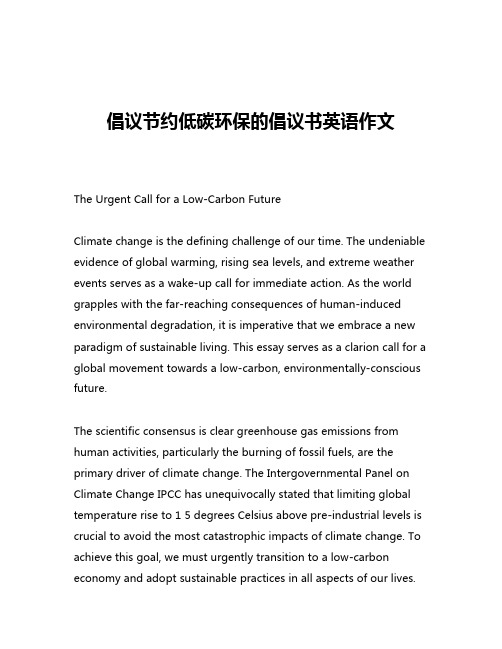
倡议节约低碳环保的倡议书英语作文The Urgent Call for a Low-Carbon FutureClimate change is the defining challenge of our time. The undeniable evidence of global warming, rising sea levels, and extreme weather events serves as a wake-up call for immediate action. As the world grapples with the far-reaching consequences of human-induced environmental degradation, it is imperative that we embrace a new paradigm of sustainable living. This essay serves as a clarion call for a global movement towards a low-carbon, environmentally-conscious future.The scientific consensus is clear greenhouse gas emissions from human activities, particularly the burning of fossil fuels, are the primary driver of climate change. The Intergovernmental Panel on Climate Change IPCC has unequivocally stated that limiting global temperature rise to 1 5 degrees Celsius above pre-industrial levels is crucial to avoid the most catastrophic impacts of climate change. To achieve this goal, we must urgently transition to a low-carbon economy and adopt sustainable practices in all aspects of our lives.The urgency of this transition cannot be overstated Rising sea levels threaten coastal communities and island nations, while extreme weather events such as hurricanes, wildfires, and droughts are becoming more frequent and intense. These climate-related disasters not only devastate local communities but also disrupt global supply chains, leading to economic upheaval and exacerbating social inequalities. Furthermore, the degradation of natural ecosystems and the loss of biodiversity pose grave risks to the delicate balance of our planet's life-sustaining systems.Addressing the climate crisis requires a multi-pronged approach that encompasses individual, community, and global action. At the individual level, we must embrace a low-carbon lifestyle by reducing our energy consumption, adopting renewable energy sources, and making sustainable choices in our daily lives. This includes opting for energy-efficient appliances, reducing waste, and embracing sustainable modes of transportation such as walking, cycling, or using public transit.Moreover, we must recognize that our individual actions have a ripple effect on the broader community. By engaging in local initiatives, such as supporting renewable energy projects, participating in community gardens, or advocating for green urban planning, we can amplify the impact of our personal efforts.Encouraging our friends, family, and neighbors to adopt sustainable practices can create a groundswell of change that resonates throughout our communities.At the global level, governments, businesses, and international organizations must collaborate to implement comprehensive policies and strategies to address climate change. This includes setting ambitious emissions reduction targets, investing in renewable energy infrastructure, and incentivizing the development of green technologies. Policymakers must also prioritize the protection of natural ecosystems, promote sustainable agriculture, and ensure a just transition for workers and communities affected by the shift away from fossil fuels.Furthermore, the private sector has a critical role to play in driving the transition to a low-carbon economy. Corporations must embrace sustainability as a core business strategy, integrating environmental considerations into their operations, supply chains, and product development. By investing in renewable energy, implementing circular economy principles, and prioritizing sustainable practices, businesses can lead the way towards a more sustainable future.The challenge of climate change is daunting, but it also presents a unique opportunity for global cooperation and innovation. By working together, we can harness the power of human ingenuity todevelop clean energy solutions, sustainable agricultural practices, and circular economic models that decouple economic growth from environmental degradation. This transition will not only mitigate the impacts of climate change but also create new green jobs, improve public health, and foster more resilient and equitable communities.In conclusion, the call for a low-carbon, environmentally-conscious future is a moral imperative that transcends national boundaries and individual interests. By taking collective action at the individual, community, and global levels, we can build a sustainable future that safeguards the planet for generations to come. The time for action is now let us heed the clarion call and embark on a transformative journey towards a more resilient, equitable, and environmentally-just world.。
低碳经济外文文献

低碳经济外文文献低碳经济外文文献综述引言:近年来,气候变化和能源安全已成为全球关注的焦点。
为了应对气候变化和减少温室气体排放,低碳经济逐渐成为发展的趋势。
低碳经济旨在通过减少对化石燃料的依赖,推动清洁能源的使用,并促进可持续发展。
本文将概述与低碳经济相关的外文文献,以深入探讨这一主题的多个方面。
1. 气候变化和低碳经济研究表明,人类活动导致的温室气体排放是气候变化的主要原因。
低碳经济可以降低温室气体排放,减缓气候变化速度。
通过开发清洁能源、提高能源利用效率和推广低碳技术,低碳经济可以减轻对环境的压力并促进可持续发展。
2. 低碳技术和创新低碳经济需要依赖创新的低碳技术来推动转型。
外文文献中提及了一些低碳技术,如可再生能源、能源储存技术、智能电网和碳捕获与封存技术。
这些技术的发展和应用将有助于实现低碳经济的目标,并为经济增长和就业创造新的机会。
3. 政策和金融支持为促进低碳经济的发展,各国纷纷采取了政策和金融支持措施。
外文文献中涉及到的政策包括碳排放交易、碳税和可再生能源配额制度。
金融支持措施如绿色金融和碳资本市场也被广泛应用。
这些政策和金融工具为低碳经济提供了必要的支持和动力。
4. 低碳经济的机遇和挑战低碳经济带来了许多机遇,如清洁能源市场的发展、创新和技术进步的推动以及工业升级和转型的机会。
然而,低碳经济也面临着挑战,如技术成本高昂、能源转型和领域差异问题。
通过研究外文文献,我们可以更加全面地了解这些机遇和挑战,并为低碳经济的实施提供更具体、可行的建议。
5. 低碳经济的实施案例外文文献中提到了一些国家和地区实施低碳经济的案例。
欧盟制定了一系列政策和目标来推动低碳经济的转型,并通过建立碳市场来减少温室气体排放。
中国也采取了类似的措施,致力于减少碳排放和提高能源效率。
这些实施案例可以为其他国家和地区在低碳经济领域的发展提供借鉴和经验。
结论:低碳经济是应对气候变化和可持续发展的重要途径。
本文通过综述与低碳经济相关的外文文献,深入探讨了气候变化和低碳经济、低碳技术和创新、政策和金融支持、机遇和挑战以及实施案例等多个方面。
减缓全球变暖的措施英语作文

减缓全球变暖的措施英语作文英文回答:Global warming is a critical issue that poses a significant threat to our planet and all living organisms. Although the phenomenon has been occurring naturally throughout Earth's history, human activities have amplified its effects to unprecedented levels. The burning of fossil fuels, deforestation, and industrial processes release greenhouse gases into the atmosphere, leading to an increase in global temperatures.Recognizing the urgency of addressing global warming, nations worldwide have taken steps to mitigate its impacts and transition to a sustainable future. The following measures are crucial in reducing greenhouse gas emissions and mitigating the effects of climate change:1. Transitioning to Renewable Energy Sources:Replacing fossil fuels with renewable energy sources, such as solar, wind, and geothermal energy, is essential. These sources do not emit greenhouse gases during energy production, contributing significantly to decarbonization efforts.2. Energy Efficiency Improvements:Improving energy efficiency in all sectors, including buildings, transportation, and industry, reduces energy consumption and lowers emissions. By using energy-efficient appliances, implementing energy-saving practices, and optimizing energy systems, we can significantly reduce our energy footprint.3. Reforestation and Afforestation:Trees absorb carbon dioxide from the atmosphere during photosynthesis, acting as carbon sinks. Planting trees and restoring forests not only sequesters carbon but also provides numerous other benefits, such as improving biodiversity and air quality.4. Technological Advancements:Research and development in clean technologies, such as carbon capture and storage (CCS), can play a significant role in reducing greenhouse gas emissions. CCS involves capturing carbon dioxide from industrial or power plants and storing it underground, preventing its release into the atmosphere.5. Policy and Regulatory Measures:Governments must implement effective policies and regulations to support and incentivize the transition to a low-carbon economy. Setting emission reduction targets, promoting renewable energy development, and investing in climate mitigation measures are essential for driving transformative change.6. Public Awareness and Education:Raising public awareness about the causes andconsequences of global warming and promoting sustainable practices is crucial. Empowering individuals and communities with knowledge can lead to behavioral changes that support climate action.7. International Cooperation:Climate change is a global issue that transcendsnational borders. International collaboration and cooperation are vital in tackling this challengeeffectively. Global agreements, such as the Paris Agreement, provide frameworks for coordinated efforts and collective action to reduce emissions.中文回答:减缓全球变暖的措施。
低碳经济中英文外文文献
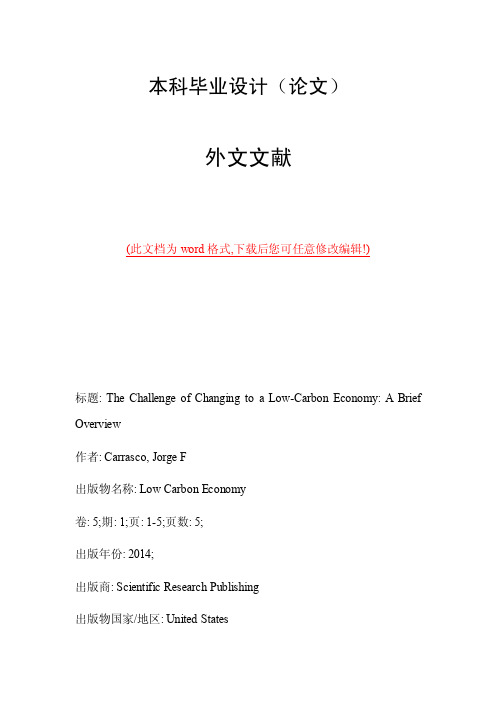
本科毕业设计(论文)外文文献(此文档为word格式,下载后您可任意修改编辑!)标题: The Challenge of Changing to a Low-Carbon Economy: A Brief Overview作者: Carrasco, Jorge F出版物名称: Low Carbon Economy卷: 5;期: 1;页: 1-5;页数: 5;出版年份: 2014;出版商: Scientific Research Publishing出版物国家/地区: United StatesISSN: 21587000The Challenge of Changing to a Low-Carbon Economy: A BriefOverviewCarrasco, Jorge FAbstractClimate change alters all sustainable development dimensions for a given nation or region, therefore, decreasing emission of GHG is not only an environmental issue, but it has also implication on the economic, social and political matters. In 2009, the Copenhagen Accord adopted the 2°C global warming increase limit as an international policy, being this threshold the maximum allowable warming to avoid dangerous and irreversible anthropogenic interference in the climate system. The observed monthly average CO^sub 2^ concentrations in the atmosphere crossed the 400 parts per million thresholds, for the first time in April and May 2013. The energy sector is the single largest source of climate changing GHG emissions, and therefore moving from fossil fuel to clean energy production should be a priority challenge for all countries. For that, it is necessary to develop a low carbon economy for confronting the climate change.Keywords:Climate Change; Carbon Dioxide; Low-Carbon Economy; 2°C Target1. OverviewSince the release of the Fourth Assessment Report of the Intergovernmental Panel on Climate Change (IPCC) [1], when the main conclusion was that the climate change is unequivocal; the vast majority of the world reached the consensus that this environmental change is real and it is due to the atmosphere warming as a con- sequence of the increased concentration of greenhouse gases (GHG) of anthropogenic origin. This has recently been confirmed by the Fifth IPCC Report [2]. One of the main conclusions indicates that "human influence has been detected in warming of the atmosphere and the ocean, as well as, changes in the global water cycle, in re- ductions in snow and ice, in global mean sea level rise, and in changes in some climate extremes". Also, the re- port reveals that "it is extremely likely (i.e., 95% - 100% probability) that human influence has been the domi- nant cause of the observed warming since the mid-20th century" [2]. Climate model simulations project further warming and changes in all components of the climate system as emissions of CO2 continue, or even if emis- sions of CO2 are stopped now [2]. Therefore, it is necessary to face and to be prepared for a warmer world than the present one, with an appropriate worldwide plan and/or with integrated and synergetic national programs that globally mitigate the emission of GHG. This mainly implies to end with our dependence on fossil fuels, which is the major source of carbon dioxide(CO2) released into the atmosphere, and to assume that this action is a challenge that should be the main worldwide environmental problem of our time. The CO2 is the most impor- tant anthropogenic GHG contributing ~64% to the radiative forcing of the long-lived GHG, and it is responsible for ~84% of the increment in radiative forcing since 2002 [3]. Climate change alters all sustainable development dimensions for a given nation or region, therefore, de- creasing emission of GHG is not only an environmental issue, but it has also implications on the economic, so- cial and political matters. Since this issue was recognized by the global community, several actions and agree- ments have been taking place in the Conference of the Parties (COP) of the United Nations Framework Conven- tion on Climate Change (UNFCCC). Among others, in 2009 the Copenhagen Accord endorsed the continuation of the Kyoto Protocol; it recognized that climate change is one of the greatest challenges of our time and em- phasized the needed for a "strong political will to urgently combat climate change in accordance with the prin- ciple of common but differentiated responsibilities and respective capabilities". Also, it was recognized that deep cuts in global emissions are required according to science results [1] [2] and that countries should agree in cooperative way in stopping from rising global and national GHG emissions "as soon as possible". To achieve this, it is necessary to develop a low CO2 emission strategy in order to secure a sustainabledevelopment. Later in the COP at Durban 2011, the governments recognized the need of a new universal, legal agreement to deal with climate change beyond 2020, where all parties will play their part to the best of their ability. Meanwhile, an amendment to the Kyoto Protocol was adopted in the COP at Doha 2012 where the parties agreed on an 8-year second commitment period, this in order to stabilize greenhouse gas concentrations in the atmosphere at a level that will prevent dangerous human interference with the climate system.Also, the Copenhagen Accord adopted the 2°C global warming increase limit [4] as an international policy, being this threshold the maximum allowable warming to avoid dangerous and irreversible anthropogenic inter- ference in the climate, beyond this threshold the risks of significant damage to ecosystems and of non-linear responses are expected to increase rapidly. These actions are now even more urgent after knowing the results of the last Fifth IPCC Report [2]. The International Energy Agency (IEA) [4] also recognized that the energy sector is the single largest source of climate changing GHG emissions, and therefore changing from fossil fuel to clean energy production should be a priority challenge. This means to develop an economic based on a low-emission pathway, in other words, to establish a low carbon economy (LCE) for confronting the climate change. This im- plies a low-fossil-fuel economy, or a decarbonized economy that has a minimal output of GHGemissions into the atmosphere, specifically CO2 as a result of human activity. The IEA [5] recently indicated that even though Governments have decided collectively that the world needs to limit the average global temperature increase to no more than 2°C (as sooner as possible), any resulting global agreement related with this challenge will emerge after 2015 and new legal obligations will most probably begin after 2020. Meanwhile, despite the agreement taken by governments and that many countries are taking new ac- tions, the GHG emission continue increasing and the world target for accomplishing the 2°C is drifting further from the track that it needed to follow [5]. In fact, the observed monthly average CO2 concentrations in the at- mosphere crossed the 400 parts per million thresholds, for the first time in April and May 2013, in several ob- serving stations (Barrow/Alaska-USA, Alert/Canada, Ny-?lesund/Norway, Iza?a/Canary Islands-Spain, and Mauna Loa/Hawaii-USA) [6]. Recently, the PwC (PricewaterhouseCooper LLP) [7] revealed that the annual rate reduction of CO2 emission for the 2012-2050 period, needed to accomplish the 2°C warming target, has ris- en from 3.7% to 5.1% (Figure 1) [6]. Also, the IEA indicated in its World Energy Outlook Special Report [5] that we are more likely to increase the air temperature between 3.6°C and 5.3°C during the 21th century, com- pared with pre-industrial values (see also Peter et al. [8]). Figure 1 also shows that the business as usual projec- tion will not accomplish the 2°C targetreduction. Neither it will be if the annual reduction rate is 3.7% as origin- ally was estimated. If we continue the business as usual pathway, every year the annual reduction rate needed will be larger and therefore more challenge to achieve. Peter et al. [8] comparing the observed annual global CO2 emission with those projected by different IPCC scenarios, since the first report until those used in the fifth one, concluded that the current trend follows or even is above the worse scenario. They concluded that if the CO2 emission track continues the global warming will be above the 2°C target, and that to return to the 2°C pathway requires a sustainable global mitigation, including capture and storage CO2, but also high level of technological, social and political innovations [8].Despite of this, the 2°C target is still a feasible challenge but it is now more difficult to achieve and actions are urgently needed before 2020. It is well recognized that energy accounts for around two-third of GHG emis- sions, as more than 80% of global energy consumption is based on fossil fuels. Therefore, achieving a LCE is a worldwide challenge in order that the climate change impacts can be mitigated any time soon. Such an endeavor must be undertaken, not only by developed countries (Annex 1 of the Kioto Protocol), but it should also be a compromise by developing countries (non Annex 1 of the Kioto Protocol). However, any action should be in accordance with the principle ofcommon but differentiated responsibilities and respective capabilities. Natural energy resources are vital for securing economic growth and development for all countries, not just today but for future generations. The relationship between economic growth and the environment is complex. Changes in technology due to LCE can have the potential of reducing the environmental impacts, but also of af- fecting the economic growth. Traditional economy is based mainly on energy generated by using fossil fuel. For this reason many economical indexes include results of consumption of fossil fuel, like the economic growth, nation and people prosperity, and other overall cost and benefits. The LCE implies the development of a new way of generating energy, which it should be based on "clean-renewable" sources. For the vast majority of the countries this shift is highly cost and it will affect their economy, mainly to those less-developed communities. As indicated earlier, the international community recognizes that the climate change (and its impacts) is one of the largest problems facing humanity. This is well assumed in economic terms, but the challenge goes beyond this, arising ethical questions that many time are often overlooked, questions that have to be with ourselves and with our interaction with the environment including the ecosystems and the biodiversity. What should be the objectives of climate change, and who should bear the burdens of climate change? Who should be included in decision-making about mitigationand adaptation strategies? Is it only governmental decision? What role plays the private sector? Beinhocker and Oppenheim [9] ind icated that moving to a LCE involves a technology shift might cause job losses in some sectors, but on the other hand is likely to create more jobs than it will destroy. Also, greater social equity could be an additional benefit of such a low-carbon revolution. For example, in de- veloping countries innovations in power generation technology could make electricity both more affordable and more accessible to less-developed communities. Increased electrification has a wide variety of development benefits ranging from improved healthcare and access to clean water, to greater economic growth. Even, the de- velopment of a truly sustainable biofuels industry could offer vast economic opportunities for the rural poor communities.Clearly climate change will impact our way of life, moving to a LCE for accomplishing the goal of 2°C target will cause changes in the current social status, on the people's capacity to enjoy fundamental rights to life, food, water and health [9]. This means that the 2°C target is likely to be too high to safeguard these rights. Then, how we as worldwide society are able to confront the challenge imposed by climate change, in moving to a LCE and adopting polices for mitigation and adaptation, without compromising people's rights for a better life and the environment as a whole. No doubt that LCE requires an ethical and political frameworkthat differs from current ones.Climate change is the result of human activity involving many actors from the individual level (summing bil- lions of people), to industry and governmental levels, and from national (private and public) to international in- stitutions. To move to a LCE requires a collective action of all countries and across the entire society, from pri- vate to public sectors, from the individual to a community levels. It requires actions that go beyond legal decla- rations, (完整文献请到百度文库) from national legislatures and international agreement and involving national and international organi- zations, like the World Trade Organization and World Bank, two bodies funding research into new technologies. It also requires that these institutions coordinate and cooperate with each other to ensure that social and eco- nomic policies are not pursued in ways that destroy the environment. In many countries, the balance between private and public investment in a LCE should be driven by the market but with governmental policies and regu- lations that ensure the least impact on the most vulnerable communities. It is most probable that the private sec- tor will not act on those areas where the return investment is of long-term or highly uncertain. In these cases, ac- tion from the public sector will be needed by taking responsibility on the investment or by subsidizing private ones or to the vulnerable communities. The climate change is a global problem with a global solution, even though the responsibilitiesare differentiated, all countries should take actions, and all industries should be in- volved in moving to a LCE. Today, in a global market and economy, most industrial production is also of an in- ternational scale and, therefore, they should be involved in LCE actions.The LCE also implies the concept of low carbon technology (LCT) for energy generation and the develop- ment of new technology with zero carbon emission. This development has relationships with electricity, trans- portation and construction sectors; chemistry industry and many other new technologies. Globally, technology development has dramatically accelerated over recent decades in developed countries, however, this develop- ment remains slow in low- and middle-income countries. Technology transfer from developed to developing countries needs further implementation. Also, LCT involves research for improving efficiency of existing tech- nology and for developing new technology from renewable energy that comes from natural resources. Advances in technology and policy will allow renewable energy and energy efficiency to play major roles in replacing fos- sil fuels, meeting global energy demand, but at the same time reducing CO2 emissions. In summary, the world is facing a warmer environment due to human activity that have being increasing the GHG concentration. To overcome the impacts of the climate changes we need to adapt to the new scenarios, but also to reduce the GHG emission by moving to a LCE, which requires the compromiseof all countries and indi- viduals. LCE will impact the society in different way, for example on the economic growth which can be com- promised; it will need a balance between private and public investment, governmental policies and regulations, research and development of new technologies. It will require an international agreement where all nations should act with generosity for the well-being of humanity. AcknowledgementsThis study was carried out when the author was still affiliated with the Dirección Meteorológica de Chile. This article is a contribution to FONDAP (CR2) N° 1511009. ReferencesReferences[1] Solomon, S., Qin, D., Manning, M., Chen, Z., Marquis, M., Averyt, K.B., Tignor, M. and Miller, H.L. (2007) Contri- bution of Working Group I to the Fourth Assessment Report of the Intergovernmental Panel on Climate Change. IPCC 2007, Cambridge University Press, Cambridge and New Y ork. [2] Stocker, T.F., Qin, D., Plattner, G.-K., Alexander, L.V., Allen, S.K., Bindoff, N.L., Bréon, F.-M., Church, J.A., Cu- basch, U., Emori, S., Forster, P., Friedlingstein, P., Gillett, N., Gregory, J.M., Hartmann, D.L., Jansen, E., Kirtman, B., Knutti, R., Krishna Kumar, K., Lemke, P., Marotzke, J., Masson-Delmotte, V., Meehl, G.A., Mokhov, I., Piao, S., Ra- maswamy,V., Randall, D., Rhein, M., Rojas, M., Sabine, C., Shindell, D., Talley, L.D., V aughan, D.G. and Xie, S.-P. (2013) Technical Summary. In: Stocker, T.F., Qin, D., Plattner, G.-K., Tignor, M., Allen, S.K., Boschung, J., Nauels, A., Xia, Y., Bex, V. and Midgley, P.M., Eds., Climate Change 2013: The Physical Science Basis. Contribution of Working Group I to the Fifth Assessment Report of the Intergovernmental Panel on Climate Change. Cambridge Uni- versity Press, Cambridge and New Y ork, in Press. [3] WMO (2013) The State of the Greenhouse Gases in the Atmosphere Based on Global Observations through 2012. Greenhouse Gas Bulletin, 9, 4 p. [4] Jaeger, C.C. and Jaeger, J. (2010) Three Views of Two Degrees. European Climate Forum (ECF) Working Paper 2, Potsdam.[5] International Energy Agency (2013) Redrawing the Energy-Climate Map. [6] Bala, G. (2013) Digesting 400 ppm for Global Mean CO2 Concentration. Current Science, 104, 47-48. [7] PwC (Pricewaterhouse Coopers LLP) (2012) Too Late for Two Degrees Low Carbon Economy Index. /gx/en/sustainability/publications/low-carbon-econo my-index/index.jhtml [8] Glen, P.P., Andrew, R.M., Boden, T., Canadell, J.G., Ciais, P., Le Quere, C., Marland, G., Raupach, M.R. and Wilson, C. (2013) The Challange to Keep Global Warming below 2°C. Nature Climate Change, 3, 4-6. [9] Beinhocker, E. and Oppenheim, J. (2009)Economic Opportunities in a Low-Carbon World. UNFCCC E-Newsletter. https://unfccc.int/press/news_room/newsletter/guest_column/items/4608.php AuthorAffiliationJorge F. Carrasco1,21Dirección Meteorológica de Chile, Santiago, Chile 2Universidad de Magallanes, Punta Arenas, Chile Email:****************** Received 8 December 2013; revised 8 January 2014; accepted 16 January 2014 Copyright ?2014 by author and Scientific Research Publishing Inc. This work is licensed under the Creative Commons Attribution International License (CC BY)./licenses/by/4.0/。
和碳排放峰值相关的英语作文
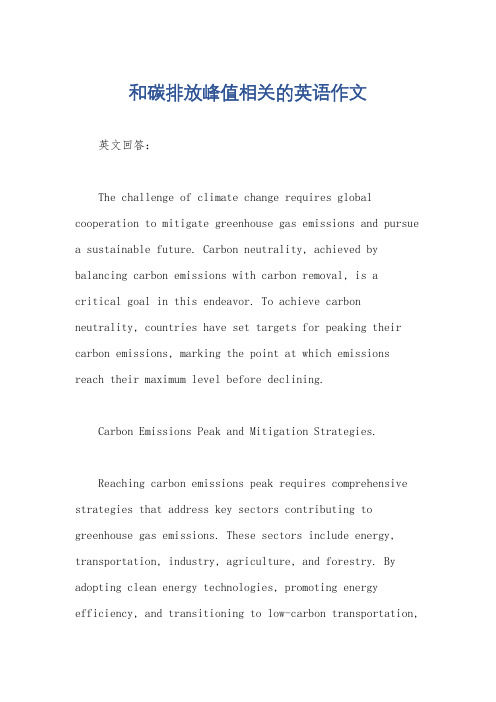
和碳排放峰值相关的英语作文英文回答:The challenge of climate change requires global cooperation to mitigate greenhouse gas emissions and pursue a sustainable future. Carbon neutrality, achieved by balancing carbon emissions with carbon removal, is acritical goal in this endeavor. To achieve carbon neutrality, countries have set targets for peaking their carbon emissions, marking the point at which emissions reach their maximum level before declining.Carbon Emissions Peak and Mitigation Strategies.Reaching carbon emissions peak requires comprehensive strategies that address key sectors contributing to greenhouse gas emissions. These sectors include energy, transportation, industry, agriculture, and forestry. By adopting clean energy technologies, promoting energy efficiency, and transitioning to low-carbon transportation,countries can significantly reduce their carbon footprint.In the energy sector, renewable energy sources such as solar, wind, and hydroelectricity can replace fossil fuels, minimizing carbon emissions. Energy-efficient technologies, such as LED lighting and smart building systems, conserve energy and reduce demand for non-renewable resources.Transportation accounts for a substantial portion of global carbon emissions. Promoting public transportation, electric vehicles, and walking or cycling can reduce emissions from this sector. Governments can implement policies that encourage these sustainable transportation modes.Industry emits greenhouse gases through manufacturing processes and energy consumption. By adopting cleaner production methods, using energy-efficient equipment, and implementing carbon capture and storage technologies, industries can mitigate their emissions.Agriculture and forestry can contribute to carbonsequestration. Sustainable farming practices, such as no-till farming and cover cropping, can enhance soil carbon storage. Reforestation and afforestation projects can absorb carbon dioxide from the atmosphere and create carbon sinks.International Cooperation and Carbon Markets.Achieving carbon emissions peak is an international responsibility. Countries must collaborate through international agreements and carbon markets to share best practices, coordinate emissions reduction efforts, and ensure a just and equitable transition to a carbon-neutral economy.Carbon markets provide a platform for countries and businesses to trade carbon credits, incentivizing emissions reductions and financing clean energy projects. By pricing carbon emissions, carbon markets create a financial incentive for polluters to reduce their emissions.Benefits of Emissions Peak and Carbon Neutrality.Reaching carbon emissions peak and achieving carbon neutrality offer numerous benefits, including:Improved air quality and human health.Reduced climate change impacts, such as extreme weather events and sea-level rise.Transition to a sustainable and low-carbon economy.Creation of new jobs and economic opportunities.Enhanced energy security and resilience.中文回答:碳排放达峰与减排策略。
保护环境低碳生活倡议书英语作文万能模板
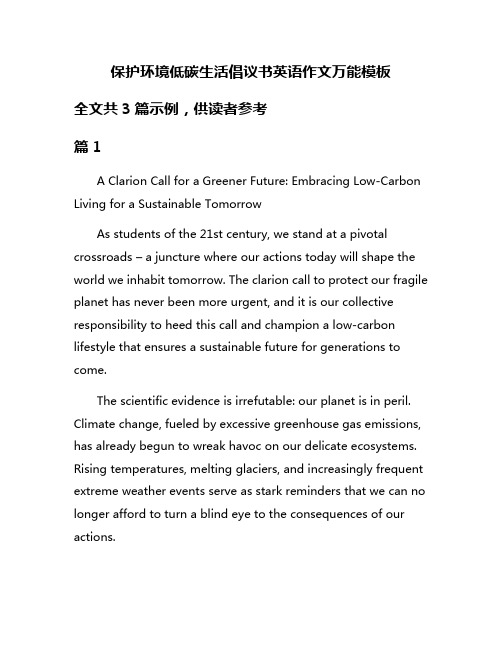
保护环境低碳生活倡议书英语作文万能模板全文共3篇示例,供读者参考篇1A Clarion Call for a Greener Future: Embracing Low-Carbon Living for a Sustainable TomorrowAs students of the 21st century, we stand at a pivotal crossroads – a juncture where our actions today will shape the world we inhabit tomorrow. The clarion call to protect our fragile planet has never been more urgent, and it is our collective responsibility to heed this call and champion a low-carbon lifestyle that ensures a sustainable future for generations to come.The scientific evidence is irrefutable: our planet is in peril. Climate change, fueled by excessive greenhouse gas emissions, has already begun to wreak havoc on our delicate ecosystems. Rising temperatures, melting glaciers, and increasingly frequent extreme weather events serve as stark reminders that we can no longer afford to turn a blind eye to the consequences of our actions.It is incumbent upon us, the youth of today, to take the lead in this battle against environmental degradation. We must recognize that our choices, no matter how small, havefar-reaching implications for the well-being of our planet. By embracing a low-carbon lifestyle, we can collectively make a significant dent in our carbon footprint and pave the way for a greener, more sustainable future.The path to a low-carbon lifestyle is multifaceted, but the rewards are immeasurable. Simple actions, such as reducing energy consumption, opting for eco-friendly transportation alternatives, and minimizing waste, can have a profound impact on our environmental footprint. Imagine the collective power we can wield if each of us made conscious choices to conserve energy by turning off lights and unplugging electronics when not in use, or by embracing carpooling, cycling, or public transportation as our preferred modes of commuting.Furthermore, we must become mindful consumers, scrutinizing the products we purchase and the companies we support. By prioritizing sustainable and ethically-sourced goods, we can incentivize businesses to adopt environmentally-friendly practices and drive positive change within industries. Everypurchase we make is a vote for the kind of world we want to inhabit, and it is our responsibility to cast our votes wisely.Education plays a crucial role in this crusade for a greener future. We must equip ourselves with knowledge about the intricate workings of our planet and the impact of our actions on its delicate balance. By fostering a deeper understanding of environmental issues, we can inspire others to join us in this noble cause and collectively work towards innovative solutions that harmonize human progress with ecological preservation.Moreover, we must raise our voices and advocate for stronger environmental policies and regulations. As the inheritors of this planet, we have a vested interest in ensuring that our leaders prioritize sustainable development and implement measures that safeguard our natural resources for future generations. Through civic engagement, grassroots movements, and active participation in the political process, we can hold our elected officials accountable and demand decisive action on climate change mitigation and environmental protection.The journey towards a low-carbon future will not be without challenges, but the rewards of our efforts will be immeasurable. By embracing sustainable practices today, we can bequeath alegacy of hope and resilience to those who will inherit this planet tomorrow. Imagine a world where clean air and pristine waters are the norm, where biodiversity thrives, and where the scourge of climate change has been tamed by our collective resolve.In this pursuit of a greener future, we must not forget the importance of collaboration and unity. Environmental challenges know no borders, and their impact transcends geographical boundaries. By fostering international cooperation and sharing knowledge and best practices, we can amplify our efforts and accelerate the transition towards a low-carbon global economy.Let us not be deterred by the magnitude of the task at hand. Instead, let us draw inspiration from the countless individuals and organizations who have already begun to chart the course towards a more sustainable future. From pioneering scientists and innovators to grassroots activists and conscientious consumers, their unwavering dedication serves as a beacon of hope, reminding us that positive change is within our grasp if we remain steadfast in our commitment.In the grand tapestry of human history, our generation has the unique opportunity to be the catalysts of transformative change. Let us seize this moment and embrace a low-carbon lifestyle, not merely as a fleeting trend, but as a fundamentalshift in our collective consciousness. By making sustainable choices and advocating for environmental protection, we can ensure that our planet remains a thriving, vibrant home for generations to come.The time to act is now. Let us join hands and embark on this journey towards a greener future, secure in the knowledge that our efforts will echo through the ages, forever etching our names in the annals of those who dared to dream and fought for a better world.篇2A Student's Call to Action: Embracing a Low-Carbon Lifestyle for a Sustainable FutureAs students of the 21st century, we stand at a critical juncture where our actions today will shape the world of tomorrow. The reality of climate change and environmental degradation has become increasingly evident, calling for a collective effort to mitigate its impact and pave the way for a sustainable future. It is our responsibility, as the torchbearers of this generation, to raise our voices and advocate for alow-carbon lifestyle that prioritizes environmental protection.The consequences of inaction are far too grave to ignore. The scientific evidence is overwhelming – rising global temperatures, melting ice caps, extreme weather patterns, and the extinction of countless species are just a few of the alarming consequences we face if we fail to act. It is a harsh reality that our planet's resources are finite, and our current consumption patterns are unsustainable. We must recognize that our individual choices and lifestyles have a profound impact on the environment, and it is imperative that we make conscious efforts to reduce our carbon footprint.Embracing a low-carbon lifestyle is not merely a trend; it is a necessity for the well-being of our planet and the generations to come. By making simple yet impactful changes in our daily lives, we can collectively contribute to a greener and more sustainable future. Let us start by examining our transportation choices. Whenever possible, we should opt for eco-friendly modes of transportation, such as walking, cycling, or using public transit. Not only does this reduce our carbon emissions, but it also promotes physical activity and a healthier lifestyle.Furthermore, we must reevaluate our consumption patterns and strive for a more conscious and mindful approach. Reducing our reliance on single-use plastics, opting for reusable andsustainable products, and supporting businesses that prioritize environmental responsibility are all steps in the right direction. By making informed choices as consumers, we can create a ripple effect that encourages companies to adopt more sustainable practices.Energy conservation should also be a priority in our daily lives. Simple actions like turning off lights and electronics when not in use, using energy-efficient appliances, and exploring renewable energy sources can significantly reduce our carbon footprint. Additionally, we should embrace a plant-based or reduced-meat diet, as the livestock industry is a significant contributor to greenhouse gas emissions.Education and awareness are crucial components of this movement. As students, we have the unique opportunity to engage our peers, families, and communities in discussions about environmental issues and the importance of sustainable living. By sharing our knowledge and inspiring others to join this cause, we can amplify our impact and foster a culture of environmental stewardship.Moreover, we must advocate for policy changes and hold our leaders accountable for their actions related to environmental protection. By actively participating in civicengagement, attending rallies and protests, and voicing our concerns through various platforms, we can influence decision-makers to prioritize sustainable development and implement policies that support a low-carbon economy.It is important to recognize that embracing a low-carbon lifestyle is not just an individual endeavor; it requires a collective effort from all sectors of society. Governments, businesses, and organizations must collaborate and implement comprehensive strategies to address climate change and promote sustainable practices. As students, we can play a pivotal role in advocating for these changes and holding stakeholders accountable.Furthermore, we must acknowledge the interconnectedness of environmental issues with social and economic factors. Environmental degradation disproportionately affects marginalized communities and exacerbates existing inequalities. By advocating for environmental justice and promoting inclusive policies that address the needs of vulnerable populations, we can ensure a just transition towards a sustainable future.In conclusion, the time to act is now. The urgency of addressing climate change and protecting our planet cannot be overstated. As students, we have the power to shape the narrative and inspire a global movement towards a low-carbonlifestyle. By making conscious choices, educating ourselves and others, and advocating for policy changes, we can collectively create a ripple effect that transcends borders and generations.Let us embrace this call to action with resilience, determination, and a unwavering commitment to a sustainable future. Our planet is our home, and it is our sacred duty to safeguard its well-being for ourselves and for the countless generations to come. Together, we can inspire change, ignite hope, and pave the way for a greener, more sustainable tomorrow.篇3A Call to Action: Embracing a Low-Carbon Lifestyle for a Sustainable FutureMy fellow students, the time has come for us to take a stand and be the driving force behind a monumental shift towards a more sustainable way of life. As the inheritors of this planet, it is our sacred duty to safeguard its well-being for generations to come. The escalating climate crisis demands immediate action, and we, the youth, must lead the charge in mitigating its devastating consequences.For too long, we have been passive bystanders, allowing the relentless exploitation of our planet's resources to continue unchecked. The alarming rate of environmental degradation, fueled by our insatiable appetite for fossil fuels and unsustainable practices, has pushed our beloved Earth to the brink of irreversible damage. The time to act is now, and the solution lies in embracing a low-carbon lifestyle – a way of living that harmonizes our needs with the planet's carrying capacity.Imagine a world where our daily choices contribute to a greener, cleaner, and more sustainable future. A world where we walk with a lighter footprint, leaving behind a legacy of environmental stewardship for future generations. This vision is not a mere utopian dream; it is an attainable reality if we collectively commit to making the necessary changes.The cornerstone of this transformation lies in our ability to reduce our carbon footprint. We must critically evaluate our energy consumption patterns and transition towards renewable sources like solar, wind, and hydroelectric power. By embracing these clean alternatives, we can significantly curtail our reliance on fossil fuels, the primary culprits behind the escalating greenhouse gas emissions that are driving climate change.But our efforts cannot stop there. We must also examine our transportation choices and make conscious decisions to favor eco-friendly modes of mobility. Carpooling, using public transportation, cycling, or even walking whenever possible can collectively contribute to a substantial reduction in emissions. Moreover, we should advocate for the development of infrastructure that supports and encourages these sustainable transportation options.Our commitment to a low-carbon lifestyle extends far beyond energy and transportation; it permeates every aspect of our daily lives. We must reevaluate our consumption habits and embrace the principles of reduce, reuse, and recycle. By minimizing our waste generation and consciously choosing products with minimal packaging and longer lifespans, we can alleviate the strain on our planet's finite resources.Furthermore, we should embrace sustainable dietary choices by incorporating more plant-based options into our meals. The livestock industry is a significant contributor to greenhouse gas emissions, and by reducing our meat consumption, we can play a vital role in mitigating its environmental impact.Education is the catalyst for change, and we must equip ourselves with the knowledge and skills necessary to navigatethis transformative journey. We should actively seek out opportunities to learn about sustainable practices, engage in environmental initiatives, and share our knowledge with others. By fostering a culture of environmental awareness and stewardship, we can inspire and empower our peers to join us in this noble endeavor.However, our efforts alone are not enough. We must raise our voices and advocate for policy changes that prioritize environmental protection and incentivize sustainable practices. We should engage with local and national leaders, demanding accountability and concrete actions to address the climate crisis. Our collective voice has the power to influence decision-makers and shape the policies that will guide our society towards a more sustainable future.My fellow students, the path ahead is not without challenges, but the rewards of our commitment are immeasurable. By embracing a low-carbon lifestyle, we not only safeguard the planet for future generations but also cultivate a sense of personal fulfillment and responsibility. We become agents of change, standing at the forefront of a global movement that transcends boundaries and unites humanity in a common cause.Let us seize this opportunity to be the catalysts of a greener, more sustainable world. Together, we can inspire others to join our ranks, creating a ripple effect that reverberates across communities, nations, and continents. Our actions today will echo through the ages, shaping the narrative of our generation as one that stood up for the planet and paved the way for a brighter, more sustainable future.The time to act is now. Let us embrace a low-carbon lifestyle and lead the charge towards a greener, more sustainable tomorrow. Our planet deserves nothing less than our unwavering commitment and collective efforts. Let us be the generation that turned the tide, the generation that left an indelible mark of environmental stewardship for those who will inherit this Earth after us.。
气候变化对人类的影响英语作文
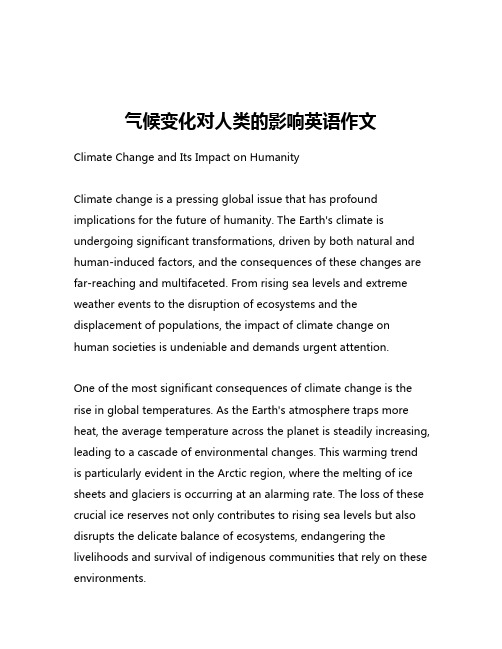
气候变化对人类的影响英语作文Climate Change and Its Impact on HumanityClimate change is a pressing global issue that has profound implications for the future of humanity. The Earth's climate is undergoing significant transformations, driven by both natural and human-induced factors, and the consequences of these changes are far-reaching and multifaceted. From rising sea levels and extreme weather events to the disruption of ecosystems and the displacement of populations, the impact of climate change on human societies is undeniable and demands urgent attention.One of the most significant consequences of climate change is the rise in global temperatures. As the Earth's atmosphere traps more heat, the average temperature across the planet is steadily increasing, leading to a cascade of environmental changes. This warming trend is particularly evident in the Arctic region, where the melting of ice sheets and glaciers is occurring at an alarming rate. The loss of these crucial ice reserves not only contributes to rising sea levels but also disrupts the delicate balance of ecosystems, endangering the livelihoods and survival of indigenous communities that rely on these environments.Rising sea levels pose a grave threat to coastal regions around the world. As the world's ice caps and glaciers continue to melt, the resulting influx of water into the oceans is causing sea levels to rise at an accelerated pace. This inundation of land threatens the homes and livelihoods of millions of people living in low-lying areas, forcing them to relocate and abandon their traditional way of life. The displacement of these populations can lead to social upheaval, increased competition for scarce resources, and the potential for conflict.Moreover, the impact of climate change on the global weather patterns is becoming increasingly evident. Extreme weather events, such as hurricanes, droughts, and heat waves, are becoming more frequent and more intense, inflicting significant damage on communities and infrastructure. These natural disasters not only disrupt economic activity and social stability but also have devastating consequences for human health and well-being. The destruction of homes, the disruption of food and water supplies, and the spread of diseases can all have long-lasting impacts on vulnerable populations.The effects of climate change extend beyond the physical environment and have profound implications for human health. As the climate continues to warm, the spread of vector-borne diseases,such as malaria and Zika, is likely to increase, exposing more people to these potentially deadly illnesses. Additionally, the impact of air pollution, which is exacerbated by climate change, can lead to a range of respiratory and cardiovascular problems, further contributing to the decline of public health.The economic consequences of climate change are also significant and far-reaching. The disruption of agricultural systems, the depletion of natural resources, and the increased costs of adaptation and mitigation measures can all contribute to economic instability and the widening of existing inequalities. Developing countries, which often lack the resources and infrastructure to cope with the effects of climate change, are particularly vulnerable to these economic shocks, further exacerbating global disparities.In response to these daunting challenges, the international community has undertaken various initiatives to mitigate the impact of climate change and promote sustainable development. The Paris Agreement, adopted in 2015, represents a global commitment to limit the rise in global temperatures and transition towards a low-carbon economy. However, the success of these efforts will ultimately depend on the collective action of governments, businesses, and individuals to embrace sustainable practices, reduce greenhouse gas emissions, and adapt to the changing climate.As we confront the realities of climate change, it is clear that the impact on humanity is multifaceted and far-reaching. From the displacement of populations and the disruption of ecosystems to the threats to human health and economic stability, the consequences of a warming planet demand a comprehensive and collaborative response. By recognizing the urgency of this issue and taking decisive action to address it, we can work towards a more sustainable and resilient future for all.。
中国如何应对气候变化英语作文

中国如何应对气候变化英语作文Climate Change: China's ResponseIntroduction:Climate change has emerged as one of the most pressing global challenges in recent years. As the world's largest emitter of greenhouse gases, China plays a crucial role in addressing this issue. In this essay, we will explore how China has been tackling climate change and highlight some of its key initiatives.The Importance of Climate Action:Recognizing the significance of climate action, China has made substantial efforts to mitigate the adverse impacts of climate change. The Chinese government acknowledges that addressing climate change is vital for both environmental sustainability and social-economic development. To achieve this, China has implemented various strategies and policies at national, regional, and local levels.Renewable Energy Development:One notable initiative undertaken by China is its significant investment in renewable energy development. By focusing on clean energy sources such as wind, solar, and hydropower, China aims to decrease its reliance on fossil fuels and reduce greenhouse gas emissions. Remarkably, China has become the world's leading investor in renewable energy technologies, including solar panels and wind turbines.Carbon Emission Reduction Targets:China has also set ambitious targets to curb carbon emissions. In 2020, President Xi Jinping announced that China would strive to reach peak carbon dioxide emissions before 2030 and achieve carbon neutrality by 2060. These targets demonstrate China's commitment to transitioning towards a green and low-carbon economy.Emissions Trading System (ETS):To further enhance its carbon reduction efforts, China has launched a national emissions trading system (ETS). This market-based approach places a cap on overall emissions while allowing companies to trade emission allowances. Bypricing carbon emissions, the ETS incentivizes companies to reduce their emissions efficiently and invest in cleaner technologies.Afforestation Initiatives:Recognizing the importance of forests in mitigating climate change impacts, China has embarked on extensiveafforestation initiatives. The "Great Green Wall" project aims to combat desertification by planting trees along the country's northern regions. Additionally, China has implemented tree-planting campaigns nationwide to increase forest cover and enhance carbon sequestration.International Cooperation:China acknowledges that addressing climate change requires global collaboration. The country actively participates in international climate conferences such as the UnitedNations Framework Convention on Climate Change (UNFCCC) and works closely with other nations to drive collective action. Through partnerships, technology transfer, and capacity building programs, China seeks to promote global climate resilience.Green Transportation:China recognizes the significant contribution of transportation to carbon emissions. To address this issue, the government has been promoting electric vehicles (EVs) as an alternative to traditional gasoline-powered vehicles. The construction of EV charging infrastructure across the country and generous subsidies for EV purchases have accelerated the adoption of sustainable transport.Conclusion:In conclusion, China's response to climate change has been substantial and commendable. From renewable energy development to setting ambitious emission reduction targets and implementing market-based approaches like ETS, China is actively working towards a greener future. International cooperation, afforestation initiatives, and promoting green transportation further demonstrate China's commitment to mitigating climate change. As a responsible global citizen, China continues to play a crucial role in shaping theworld's response to this pressing challenge.。
“低碳生活”的英语表达
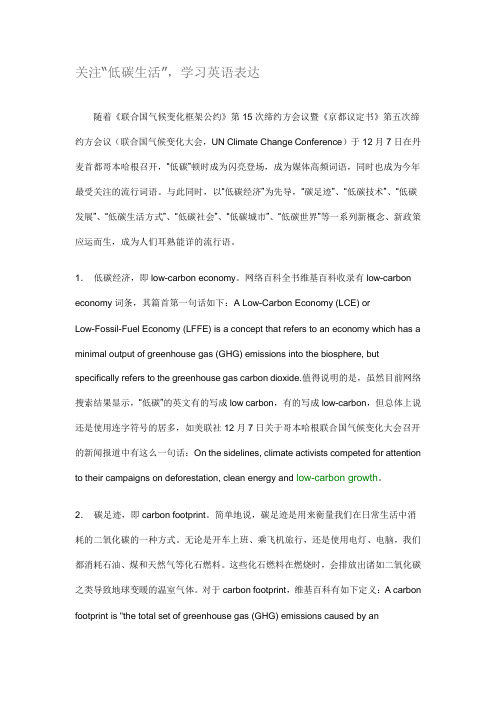
关注“低碳生活”,学习英语表达随着《联合国气候变化框架公约》第15次缔约方会议暨《京都议定书》第五次缔约方会议(联合国气候变化大会,UN Climate Change Conference)于12月7日在丹麦首都哥本哈根召开,“低碳”顿时成为闪亮登场,成为媒体高频词语,同时也成为今年最受关注的流行词语。
与此同时,以“低碳经济”为先导,“碳足迹”、“低碳技术”、“低碳发展”、“低碳生活方式”、“低碳社会”、“低碳城市”、“低碳世界”等一系列新概念、新政策应运而生,成为人们耳熟能详的流行语。
1.低碳经济,即low-carbon economy。
网络百科全书维基百科收录有low-carbon economy词条,其篇首第一句话如下:A Low-Carbon Economy (LCE) orLow-Fossil-Fuel Economy (LFFE) is a concept that refers to an economy which has a minimal output of greenhouse gas (GHG) emissions into the biosphere, but specifically refers to the greenhouse gas carbon dioxide.值得说明的是,虽然目前网络搜索结果显示,“低碳”的英文有的写成low carbon,有的写成low-carbon,但总体上说还是使用连字符号的居多,如美联社12月7日关于哥本哈根联合国气候变化大会召开的新闻报道中有这么一句话:On the sidelines, climate activists competed for attention to their campaigns on deforestation, clean energy and low-carbon growth。
2.碳足迹,即carbon footprint。
气候变化与构建华北低碳经济
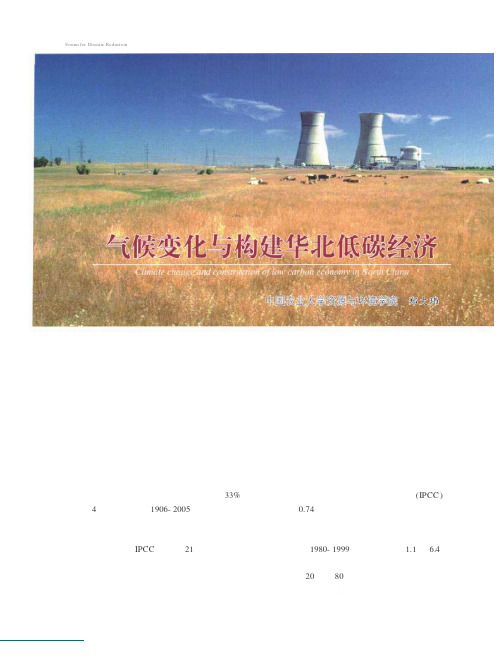
气候变化与构建华北低碳经济中国农业大学资源与环境学院郑大玮华北地区是我国对气候变化最为敏感和脆弱的地区之一,气候变化既对区域社会经济发展与生态环境造成很大影响,同时也给华北经济的转型升级带来机遇。
低碳经济是以低能耗、低污染、低排放为基础的经济模式,发展低碳经济是一场涉及生产模式、生活方式、价值观念、国家权益和人类命运的全球性革命。
低碳经济的内涵包括节能减排、开发低碳及无碳能源、增汇和适应等四方面,彼此相辅相成。
华北作为未来中国经济增长的第三极,发展低碳经济势在必行。
气候变化对华北区域经济发展与生态环境的影响全球与华北的气候变化气候变化指相对于多年平均值的巨大改变或持续较长时间的气候变动,对人类生存和生态环境都能产生重大的影响。
气候变化有自然的原因,也有人为的原因,但当代的气候变化主要由于人类活动所引起,特别是自工业革命以来,化石燃料燃烧、土地利用变化与毁林等人类活动导致大气中温室气体浓度增加了约33%,温室效应增强。
根据气候变化政府间委员会(IPCC)第4次评估报告,1906-2005年全球平均地表温度升高了0.74℃。
虽然地质史上的间冰期都是生物繁茂的时期,人类历史上的相对温暖期也是社会经济发展较快的时期,但问题是,如果气候变化的速率或程度达到一定的阈值,将会超出自然生态系统或人类社会的适应能力,从而产生灾难性的后果。
IPCC预计到21世纪末全球平均地表温度将比1980-1999年平均值升高1.1~6.4℃,可能将是近万年中增温最快的。
虽然这一预测还带有某些不确定性,但人类必须采取全球协调一致的行动来保护我们的地球家园。
如果说,气候变化在20世纪80年代基本上是一个学术问题,到了年代是关系全球社会经济可持续发展的重大战略,进入世纪,则应成为全人类的自觉行动。
与减灾与减灾中国位于欧亚大陆的东部,是世界上受气候变化影响比较突出的地区。
近百年平均气温上升0.65±0.15℃,略高于全球平均,尤其是近50年来东北和华北的增温更为明显。
绿色环保低碳生活英语作文
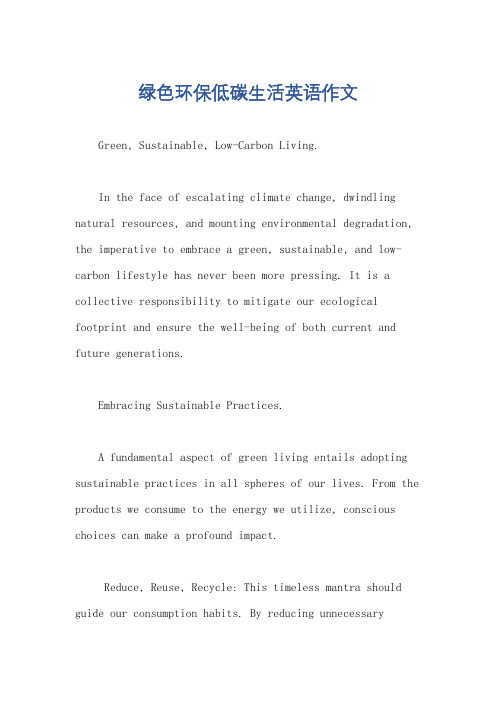
绿色环保低碳生活英语作文Green, Sustainable, Low-Carbon Living.In the face of escalating climate change, dwindling natural resources, and mounting environmental degradation, the imperative to embrace a green, sustainable, and low-carbon lifestyle has never been more pressing. It is a collective responsibility to mitigate our ecological footprint and ensure the well-being of both current and future generations.Embracing Sustainable Practices.A fundamental aspect of green living entails adopting sustainable practices in all spheres of our lives. From the products we consume to the energy we utilize, conscious choices can make a profound impact.Reduce, Reuse, Recycle: This timeless mantra should guide our consumption habits. By reducing unnecessarypurchases, reusing items whenever possible, and diligently recycling materials, we can significantly decrease waste and promote a circular economy.Choose Environmentally Friendly Products: Opting for products made from sustainable materials, such as bamboo, hemp, or recycled plastics, supports eco-conscious businesses and reduces reliance on environmentally harmful materials.Conserve Energy: Implementing energy-saving measures, such as using energy-efficient appliances, switching to LED lighting, and adjusting thermostats responsibly, not only reduces our carbon footprint but also lowers energy costs.Sustainable Transportation.Transportation plays a significant role in global carbon emissions. Embracing sustainable transportation options can drastically reduce our environmental impact.Public Transportation or Carpooling: Utilizing publictransportation systems or organizing carpools with colleagues or neighbors significantly decreases individual vehicle emissions.Cycling or Walking: For shorter distances, cycling or walking provides not only a physical workout but also zero-emission transportation.Electric Vehicles: Electric vehicles, powered by clean energy sources, offer a viable alternative to gasoline-powered cars, eliminating tailpipe emissions.Sustainable Food Choices.The food we eat has a substantial impact on the environment. Making mindful food choices can contribute to sustainable agriculture and reduce our ecological footprint.Plant-Based Diet: Adopting a plant-based diet, or reducing meat consumption, has been shown to significantly lower greenhouse gas emissions and conserve water resources.Local and Seasonal Produce: Choosing locally sourced and seasonal produce supports local farmers, reduces transportation emissions, and ensures the consumption of fresh, nutrient-rich foods.Organic Farming: Opting for organic produce minimizes the use of harmful pesticides and fertilizers, promoting biodiversity and soil health.Sustainable Home Management.Our homes can be transformed into havens of sustainability by implementing eco-friendly practices.Energy-Efficient Appliances: Investing in energy-efficient appliances, such as refrigerators, washing machines, and dryers, can dramatically reduce household energy consumption.Renewable Energy Sources: Utilizing solar panels or geothermal systems to generate renewable energy not only reduces our dependence on fossil fuels but also potentiallylowers energy bills.Water Conservation: Installing low-flow faucets, toilets, and showerheads, as well as implementing water-efficient landscaping practices, can significantly reduce water usage.Education and Advocacy.Embracing a green, sustainable, low-carbon lifestyle requires not only individual action but also collective effort. Education and advocacy are crucial for fostering environmental awareness and inspiring positive change.Education: Disseminating information about environmental issues, sustainable practices, and the impact of our choices can empower individuals to make informed decisions.Advocacy: Engaging in advocacy efforts, such as supporting environmental organizations, promoting legislation, and raising public awareness, can influencepolicy changes and catalyze systemic transformation.Collaboration: Fostering collaboration among individuals, communities, businesses, and governments is essential for creating a truly sustainable society. By pooling resources and expertise, we can accelerate progress and overcome barriers.Conclusion.The transition to a green, sustainable, low-carbon lifestyle is an ongoing journey that requires dedication, creativity, and collaboration. By embracing sustainable practices, making conscious choices, and advocating for environmental protection, we can create a future where humanity thrives in harmony with the planet. It is a responsibility we must undertake for the well-being of ourselves, our communities, and generations to come. Let us strive to live in a way that leaves a legacy of environmental stewardship and a brighter future for all.。
中国减碳行动英文演讲稿
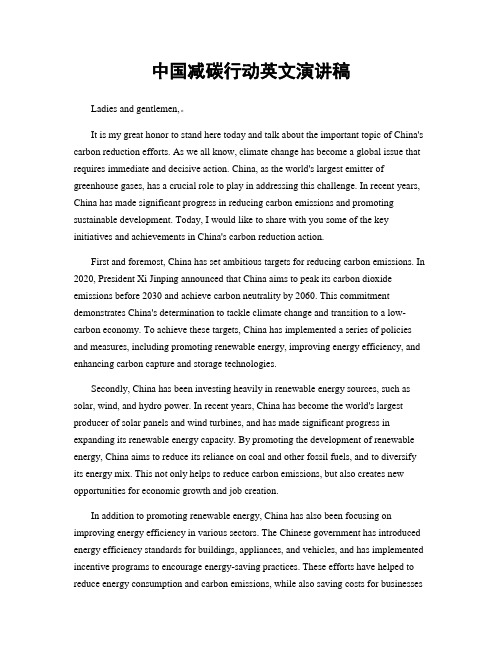
中国减碳行动英文演讲稿Ladies and gentlemen,。
It is my great honor to stand here today and talk about the important topic of China's carbon reduction efforts. As we all know, climate change has become a global issue that requires immediate and decisive action. China, as the world's largest emitter of greenhouse gases, has a crucial role to play in addressing this challenge. In recent years, China has made significant progress in reducing carbon emissions and promoting sustainable development. Today, I would like to share with you some of the key initiatives and achievements in China's carbon reduction action.First and foremost, China has set ambitious targets for reducing carbon emissions. In 2020, President Xi Jinping announced that China aims to peak its carbon dioxide emissions before 2030 and achieve carbon neutrality by 2060. This commitment demonstrates China's determination to tackle climate change and transition to a low-carbon economy. To achieve these targets, China has implemented a series of policies and measures, including promoting renewable energy, improving energy efficiency, and enhancing carbon capture and storage technologies.Secondly, China has been investing heavily in renewable energy sources, such as solar, wind, and hydro power. In recent years, China has become the world's largest producer of solar panels and wind turbines, and has made significant progress in expanding its renewable energy capacity. By promoting the development of renewable energy, China aims to reduce its reliance on coal and other fossil fuels, and to diversify its energy mix. This not only helps to reduce carbon emissions, but also creates new opportunities for economic growth and job creation.In addition to promoting renewable energy, China has also been focusing on improving energy efficiency in various sectors. The Chinese government has introduced energy efficiency standards for buildings, appliances, and vehicles, and has implemented incentive programs to encourage energy-saving practices. These efforts have helped to reduce energy consumption and carbon emissions, while also saving costs for businessesand households. Furthermore, China has been investing in research and development of advanced technologies, such as smart grid, energy storage, and electric vehicles, to further improve energy efficiency and reduce carbon emissions.Furthermore, China has been actively promoting the concept of ecological civilization and green development. The Chinese government has been working to integrate environmental protection and climate action into its economic and social development plans. For example, China has been implementing ecological restoration projects, such as afforestation and wetland restoration, to enhance carbon sequestration and biodiversity conservation. China has also been promoting sustainable urbanization and green transportation, to reduce pollution and improve the quality of life for its citizens.In conclusion, China's carbon reduction action is a crucial part of the global effort to address climate change. China has set ambitious targets, promoted renewable energy, improved energy efficiency, and embraced ecological civilization. These efforts not only contribute to reducing carbon emissions, but also create new opportunities for sustainable development and green growth. As we move forward, it is important for all countries to work together and take concrete actions to build a more sustainable and resilient future for our planet.Thank you.。
二十年后的地球生态环境英语作文
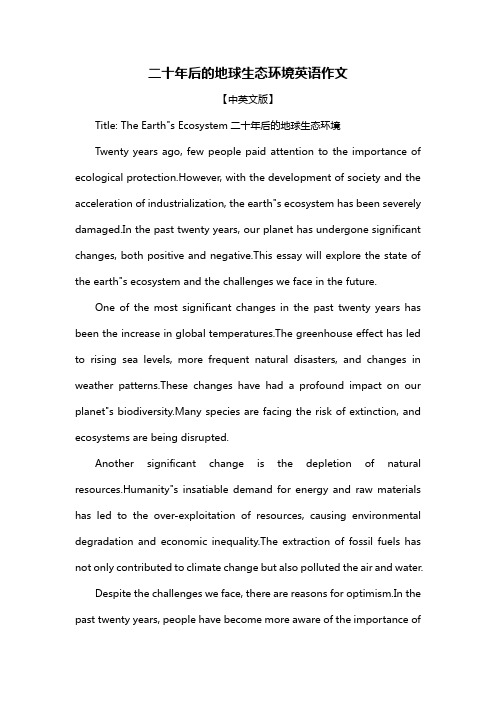
二十年后的地球生态环境英语作文【中英文版】Title: The Earth"s Ecosystem二十年后的地球生态环境Twenty years ago, few people paid attention to the importance of ecological protection.However, with the development of society and the acceleration of industrialization, the earth"s ecosystem has been severely damaged.In the past twenty years, our planet has undergone significant changes, both positive and negative.This essay will explore the state of the earth"s ecosystem and the challenges we face in the future.One of the most significant changes in the past twenty years has been the increase in global temperatures.The greenhouse effect has led to rising sea levels, more frequent natural disasters, and changes in weather patterns.These changes have had a profound impact on our planet"s biodiversity.Many species are facing the risk of extinction, and ecosystems are being disrupted.Another significant change is the depletion of natural resources.Humanity"s insatiable demand for energy and raw materials has led to the over-exploitation of resources, causing environmental degradation and economic inequality.The extraction of fossil fuels has not only contributed to climate change but also polluted the air and water.Despite the challenges we face, there are reasons for optimism.In the past twenty years, people have become more aware of the importance ofecological ernments, organizations, and individuals have taken steps to reduce their carbon footprint and preserve natural resources.Renewable energy sources such as solar and wind power have become more affordable and accessible, reducing our reliance on fossil fuels.However, we must recognize that the fight against climate change and ecological degradation is far from over.We need to take more aggressive action to protect our planet.This includes transitioning to a low-carbon economy, investing in sustainable agriculture, and promoting conservation and recycling.In conclusion, the earth"s ecosystem has undergone significant changes in the past twenty years, with both positive and negative consequences.While we have made some progress in protecting the environment, there is still much work to be done.The future of our planet depends on our willingness to take action and make sustainable choices.Only through global cooperation and a collective effort can we ensure a healthy and thriving ecosystem for future generations.。
碳达峰碳中和与标准系列解读之五
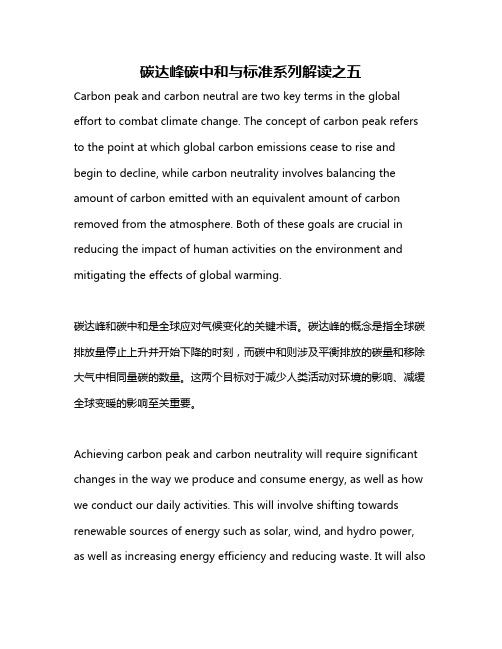
碳达峰碳中和与标准系列解读之五Carbon peak and carbon neutral are two key terms in the global effort to combat climate change. The concept of carbon peak refers to the point at which global carbon emissions cease to rise and begin to decline, while carbon neutrality involves balancing the amount of carbon emitted with an equivalent amount of carbon removed from the atmosphere. Both of these goals are crucial in reducing the impact of human activities on the environment and mitigating the effects of global warming.碳达峰和碳中和是全球应对气候变化的关键术语。
碳达峰的概念是指全球碳排放量停止上升并开始下降的时刻,而碳中和则涉及平衡排放的碳量和移除大气中相同量碳的数量。
这两个目标对于减少人类活动对环境的影响、减缓全球变暖的影响至关重要。
Achieving carbon peak and carbon neutrality will require significant changes in the way we produce and consume energy, as well as how we conduct our daily activities. This will involve shifting towards renewable sources of energy such as solar, wind, and hydro power, as well as increasing energy efficiency and reducing waste. It will alsorequire the development and implementation of new technologies and practices that can help remove carbon from the atmosphere, such as carbon capture and storage.要实现碳达峰和碳中和,我们需要对我们生产和消费能源的方式进行重大改变,以及我们的日常活动方式。
实现碳中和目标最重要的途径英语作文
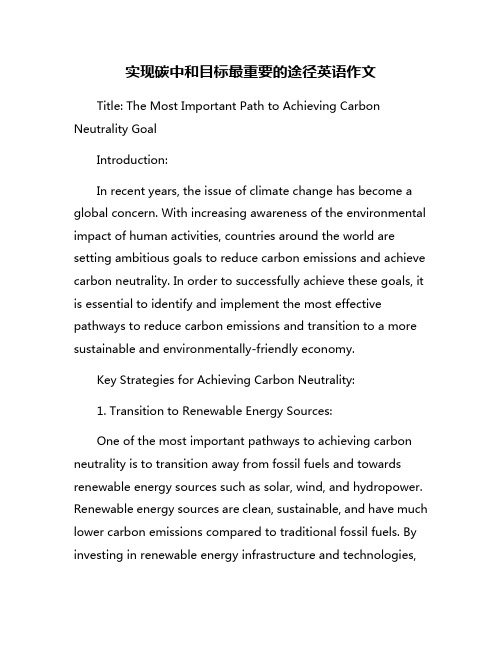
实现碳中和目标最重要的途径英语作文Title: The Most Important Path to Achieving Carbon Neutrality GoalIntroduction:In recent years, the issue of climate change has become a global concern. With increasing awareness of the environmental impact of human activities, countries around the world are setting ambitious goals to reduce carbon emissions and achieve carbon neutrality. In order to successfully achieve these goals, it is essential to identify and implement the most effective pathways to reduce carbon emissions and transition to a more sustainable and environmentally-friendly economy.Key Strategies for Achieving Carbon Neutrality:1. Transition to Renewable Energy Sources:One of the most important pathways to achieving carbon neutrality is to transition away from fossil fuels and towards renewable energy sources such as solar, wind, and hydropower. Renewable energy sources are clean, sustainable, and have much lower carbon emissions compared to traditional fossil fuels. By investing in renewable energy infrastructure and technologies,countries can significantly reduce their carbon emissions and move towards a more sustainable energy system.2. Energy Efficiency and Conservation:Improving energy efficiency and promoting energy conservation are also key strategies for achieving carbon neutrality. By implementing energy-efficient technologies and practices in buildings, transportation, and industries, countries can reduce their energy consumption and carbon emissions. Energy efficiency measures not only help to reduce carbon emissions but also lead to cost savings and increased competitiveness for businesses and households.3. Carbon Pricing and Markets:Implementing carbon pricing mechanisms such as carbon taxes or cap-and-trade systems can help to internalize the cost of carbon emissions and incentivize businesses and individuals to reduce their carbon footprint. By putting a price on carbon, countries can create economic incentives for reducing emissions and investing in low-carbon technologies. Carbon markets can also facilitate the trade of carbon credits and enable countries to meet their emission reduction targets in a cost-effective manner.4. Sustainable Land Use and Agriculture:Promoting sustainable land use and agriculture practices is another important pathway to achieving carbon neutrality. Deforestation, land degradation, and intensive agriculture are major contributors to carbon emissions and climate change. By restoring and protecting forests, adopting sustainable farming methods, and promoting agroforestry, countries can sequester carbon, reduce emissions, and enhance biodiversity and ecosystem services.5. Innovation and Technology:Investing in innovation and technology is essential for driving the transition to a low-carbon economy. Advances in renewable energy, energy storage, electric vehicles, and carbon capture and storage technologies are crucial for reducing carbon emissions and achieving carbon neutrality. Governments, businesses, and research institutions should collaborate to accelerate the development and deployment of innovative solutions for addressing climate change.Conclusion:Achieving carbon neutrality is a complex and challenging goal that requires concerted efforts from governments, businesses, and individuals. By implementing key strategies such as transitioning to renewable energy sources, improving energyefficiency, implementing carbon pricing mechanisms, promoting sustainable land use and agriculture, and investing in innovation and technology, countries can make significant progress towards reducing carbon emissions and mitigating climate change. It is essential for all stakeholders to work together and take decisive actions to achieve carbon neutrality and create a sustainable and resilient future for future generations.。
英文演讲稿议论文范文模板
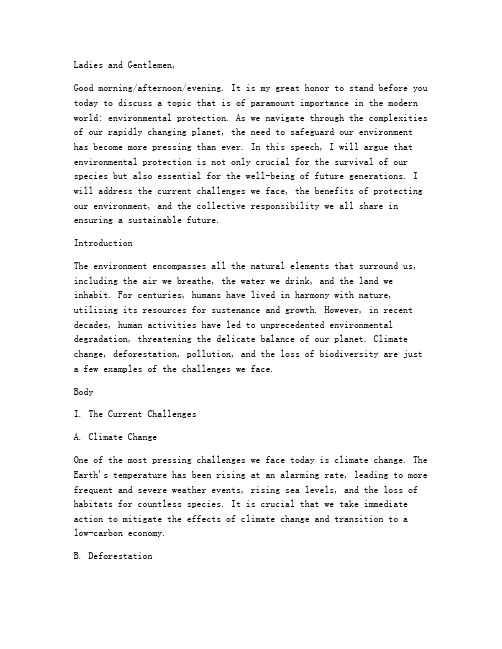
Ladies and Gentlemen,Good morning/afternoon/evening. It is my great honor to stand before you today to discuss a topic that is of paramount importance in the modern world: environmental protection. As we navigate through the complexities of our rapidly changing planet, the need to safeguard our environment has become more pressing than ever. In this speech, I will argue that environmental protection is not only crucial for the survival of our species but also essential for the well-being of future generations. I will address the current challenges we face, the benefits of protecting our environment, and the collective responsibility we all share in ensuring a sustainable future.IntroductionThe environment encompasses all the natural elements that surround us, including the air we breathe, the water we drink, and the land we inhabit. For centuries, humans have lived in harmony with nature, utilizing its resources for sustenance and growth. However, in recent decades, human activities have led to unprecedented environmental degradation, threatening the delicate balance of our planet. Climate change, deforestation, pollution, and the loss of biodiversity are just a few examples of the challenges we face.BodyI. The Current ChallengesA. Climate ChangeOne of the most pressing challenges we face today is climate change. The Earth's temperature has been rising at an alarming rate, leading to more frequent and severe weather events, rising sea levels, and the loss of habitats for countless species. It is crucial that we take immediate action to mitigate the effects of climate change and transition to alow-carbon economy.B. DeforestationThe rapid deforestation of our planet is another significant concern. Trees play a vital role in absorbing carbon dioxide, providing oxygen, and maintaining the balance of our ecosystems. The loss of forests contributes to climate change, soil erosion, and the extinction of countless species.C. PollutionPollution, in all its forms, is a severe threat to our environment. Air pollution, water pollution, and soil pollution all have detrimental effects on human health, wildlife, and the planet's overall well-being. It is essential that we implement stricter regulations and adopt cleaner technologies to reduce pollution levels.D. Loss of BiodiversityThe loss of biodiversity is a silent crisis that threatens the veryfabric of our planet. As species disappear, ecosystems become imbalanced, leading to a cascade of negative effects. We must take action to protect and preserve biodiversity for the sake of future generations.II. The Benefits of Environmental ProtectionA. Economic BenefitsEnvironmental protection can lead to significant economic benefits. By investing in renewable energy, sustainable agriculture, and green technologies, we can create jobs, stimulate economic growth, and reduce our dependence on finite resources.B. Health BenefitsA healthy environment translates to better health for all. By reducing pollution and preserving natural habitats, we can improve air quality, reduce the incidence of diseases, and promote overall well-being.C. Social BenefitsEnvironmental protection fosters a sense of community and responsibility. By working together to protect our planet, we can build stronger, moreresilient societies that are better equipped to face the challenges of the future.III. The Collective ResponsibilityThe protection of our environment is a collective responsibility that requires the participation of everyone. Governments, businesses, and individuals must all take action to reduce their environmental impact. We must demand sustainable practices from corporations, support policies that promote environmental protection, and make conscious choices in our daily lives.ConclusionIn conclusion, environmental protection is a vital issue that demands our immediate attention. The challenges we face are immense, but the benefits of protecting our environment are immeasurable. By recognizing our collective responsibility and taking action, we can secure a sustainable future for ourselves and generations to come. Let us work together to preserve the beauty and majesty of our planet, ensuring that it remains a haven for all life.Thank you for your time and attention.[Your Name]。
- 1、下载文档前请自行甄别文档内容的完整性,平台不提供额外的编辑、内容补充、找答案等附加服务。
- 2、"仅部分预览"的文档,不可在线预览部分如存在完整性等问题,可反馈申请退款(可完整预览的文档不适用该条件!)。
- 3、如文档侵犯您的权益,请联系客服反馈,我们会尽快为您处理(人工客服工作时间:9:00-18:30)。
Climate change and Low-carbon economyGlobal Economy, Institute of Economy and Management, University of HainanAbstract Global environment change with global warming as its label has occurred worldwide. It refers to long-term fluctuations in temperature, precipitation, wind, and other elements of the Earth's climate system. The human activities are considered to be one of the most active factors causing the global warming. After multi-analyzing the challenge that climatic change brings for, as a result of the development of the humanity, the article proposes that the low-carbon economy developing model is the important and feasible way for the humanity realizing the ecological civilization and achieving the sustainable development. It is suggested in this paper that much more studies on the relationship between global warming and low- carbon economy should be made in the future. China, as the largest developing country, takes the low-carbon road that company with the opportunity and also the challenge. China's low-carbon development road has to combine with their own practical and the Chinese characteristics.Key words global warming Climate change Low-carbon economy Energy1. IntroductionThe first chapter is the introduction; introduce the background and the significance of the selected topic and the research’s ideas.T he fossil fuel’s large-scale use and the global climate’s warming up since the Industrial Revolution, caused by economical rapid development, threaten seriously humanity and natural security. With the Oil price grow largely and world widely, the energy security is taken by various countries' government day by day. The international society start to make great attention in developing economy, reducing the energy consumption, reducing the greenhouse gas emissions, protecting environmentand Vigorously developing renewable energy sources.Based on such understanding, the article embarks from the low-carbon economy's concept and connotation, points out that the low-carbon economy is one kind of recent economic developing model, its core foundation is the transformation of the structure of energy consumption, Reducing the row of technological innovation, Indu strial structure’s and institutional innovations, as well as the idea of human survival’s and development’s fundamental transformation. The article reviews the viewpoint about the development of low-carbon economy, elaborate in detail about the Europe, US and Japan and other developed countries and regions’ experience and pattern. Although the specific measures are different for each developed country. Mainly formulate the corresponding policy through the legal regime, government subsidies, financial tax system and technological innovation.2. Causes of Climate changeAll objects of nature radiate energy to the surrounding in the form of electromagnetic wave, which way of spreading the energy is called radiation. In general, hot objects emit high-energy shortwave radiation outwards, while cold objects emit low-energy long-wave radiation. The gases which allow free pass of solar radiation and absorb long-wave radiation emitted by the surface are called "greenhouse gases", contributing to the “greenhouse effect” with preserving the heat of the surface. These gases consist of carbon dioxide, methane, chlorofluorocarbons, ozone, nitrogen oxides and water vapor, among which the most important is carbon dioxide. Many scientists agree that significant emissions of greenhouse gases may be the basic cause of global warming.2.1 Metabolic factorsIn recent years, population growth is one of the main factors that lead to global warming. The annual carbon dioxide discharge will be a striking figure because of massive population on the planet. It turns to be a direct result of that carbon dioxide levels in the atmosphere continue to increase. Other animals’ breathing also hasinfluence on the climate. Cattle, sheep and other ruminants will produce methane in the digestive process; the gas is the second largest greenhouse gas in the Earth that easily triggers greenhouse effect in addition to carbon dioxide.2.2 Production and lifestyle factorsScientists analyzed that the consumption of oil, coal and other fossil fuel employed by humans rises dramatically since the beginning of the industrial revolution. And there was a sharp increase in discharge of carbon dioxide as one kind of greenhouse gases, leading to global warming. By far, the fossil fuel has still been the main power of many industries.Nowadays, people’s excessive use of fertilizers has made the reduction of oxygen, and the content of nitrous oxide in marine coastal waters has been increasing. It may be an important factor in causing global warming. The nitrous oxide absorbs infrared radiation 200 times stronger than the carbon dioxide, infrared radiation being an important factor that causing global warming, so the increase in nitrous oxide will undoubtedly make global temperatures become higher.Humans burning coal, oil, natural gas and trees, a large amount of carbon dioxide and methane go into the atmosphere so as to make the planet warm, bringing about the carbon cycle imbalance and changing the energy conversion form of the Earth's biosphere. The increasing use of cars has given a certain influence on global warming. In addition, deforestation and successive wars have led to an increase in the content of greenhouse gases in varying degrees.2.3 Natural factorsWetland ecosystem is an important place to produce carbon dioxide, methane and other gases, and wetland system produces large amounts of carbon dioxide, released to the atmosphere, in the decomposition process of organic residues. Furthermore, such as volcanic eruptions, solar activity, crustal movements, changes in atmospheric circulation may also affect global warming.3.Low-carbon EconomyThe third chapter, which defines the low-carbon economy's concept and theconnotation. In this chapter, I compare the relations between the low-carbon economy and the circulation economy, at last, point out that the two important backgrounds of the low-carbon economy development are the global warming that threat to the ecological crisis and the climatic change that induce the new changes in international politics.3.1 Related conceptsLow-carbon economy: In a series of human social activities of production, circulation and consumption, actively develop the use of renewable energy and other non-fossil fuels, while at the same time achieving low carbon emissions, on the other hand,control measures are implemented to reduce carbon dioxide and other greenhouse gases emission to make it to a minimum, as a sustainable production and consumption of new economic model to prevent global warming.Low-carbon economy is essentially ecological economy, including the establishment of its connotation of low-carbon energy systems, low-carbon technologies and low-carbon industrial structure system, the establishment of production, life and consumption patterns to adapt to low-carbon development, and implementation of international and domestic stimulate low-carbon development policy, legal system and market mechanisms. It is based on the energy technology and the technology innovation of emission reduction, a fundamental change in industrial structure and institutional innovation and the development of the concept of human survival, low-carbon economy is an important, viable way to achieve ecological civilization and sustainable development.3.2 Relationship of low-carbon economy and circular economy"The so-called circular economy is the economic model running according to the natural material cycle. The development of It is in accordance with the laws of ecology running, fully considering the limited nature of the environment and natural resources. Economic development is based on material recycling, achieving the production activities eco. It is an advocate of economic development in harmony with the environment model, follow the "reduce, recycle, reuse" principle, referred to the 3R principle, using the product life-cycle processing mode to get the purpose ofreducing the physical quality of the matter entering the production process and using certain items and waste repeatedly in different ways. It is also a "resources - products - renewable resources" closed-loop feedback cycle, achieving the process from "eliminate waste" to "purify waste" and then "use of waste ", to get the coordination moderation of production, consumption and waste." Low-carbon economy and circular economy is not either-or relationship, but also a close relationship between the two connections and differences.4. ConclusionsThe forth chapter, mainly elaborate that how to construct the low-carbon development road with Chinese characters, finally tell people that develop low-carbon economy need to change their mind about consumption.4.1 Improve laws and regulationsGovernment, representing the public interest, is to develop those policies and regulations, but also solve the main flaw of the market operation mechanism. From the government's perspective, the means to promote the development of low-carbon economy has a lot through law enforcement and constraints, also the resources and the implementation of environmental laws and regulations and environmental standards implemented. Development of low-carbon economy requires special policies and regulations as support and protection. As a low-carbon economy and sustainable development model must support the rule of law and security in order to achieve its orderly and stable development, but also the inherent requirements of a low-carbon economy. Low-carbon economy requires a clear government guidance system and reliable support systems, reflecting the will of the national government. The law has normative and mandatory features ideally suited to explicitly express the concept of low-carbon economy through the development of legislation, the value of judgment and behavior.4.2Development of new energy and renewable energyHow can China have a better development of low-carbon economy? The key is to fully implement the policy measures of energy saving. Most of all, the country must strengthen the assessment of the responsibility, the base of which is theestablishment of timely and accurate statistical system and monitoring system, the core of which is to implement the targets of the emission reduction, and establish a scientific and standardized assessment system. Further strengthen responsibility of the government and corporates, to develop quantitative assessment methods and specific incentives for these provinces, the central enterprises, the provincial scale enterprises and private enterprises, and implement strict accountability.REFERENCES[1] 瞿忠琼, 陈昌春. 全球变暖对人类健康的影响与对策研究[J] . 四川环境, 2004,23(5).[2] 傅国斌, 李克让. 全球变暖与湿地生态系统的研究进展[J] . 地理研究,2001,20(1).[3] 鲍健强, 苗阳, 陈锋. 低碳经济:人类经济发展方式的新变革[J]. 中国工业经济,2008(4).[4] Richard A. Kerr. It’s official: Humans Are Behind Most of Global Warming. Science,2001,291(5504):566.[5] Ansoff H.I. Corporate Strategy: An Analytic Approach to Business Policy for Grove handExpansion [J].McGraw, StrHill, and New York.1965.[6] Abdeen Mustafa Omer. Focus on Low Carbon Technologies: The Positive Solution[J].Renewable and Sustainable Energy Reviews, 2007.海南大学课程论文课程名称: 研究生英语题目名称:Climate change and Human Health 学院:经济与管理学院专业班级:2013级世界经济姓名:何蒙萌学号:13020105210004评阅教师:2014年 6 月25 日。
